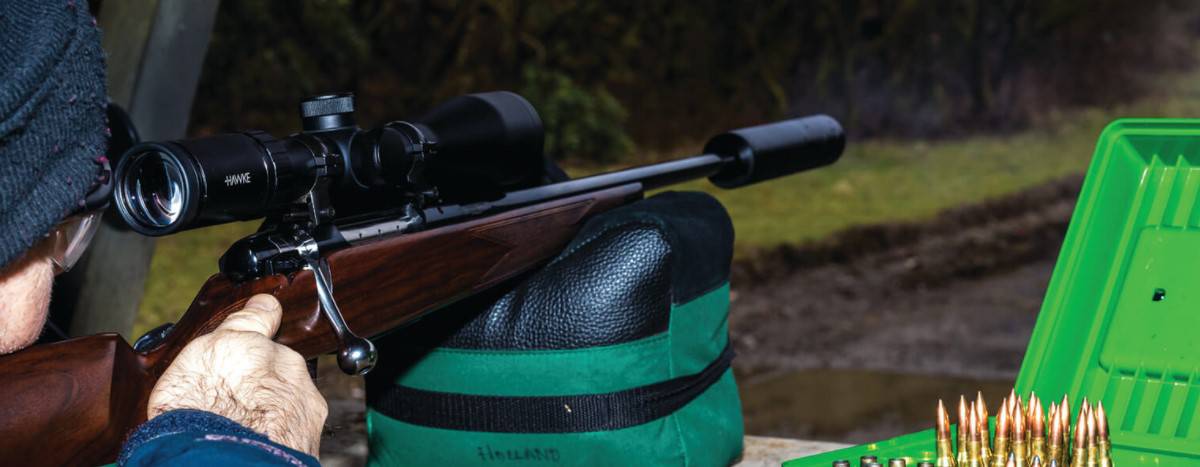I learned the hard way what makes or breaks an illuminated reticle scope. Eight years back, hunting thick cedar breaks in Central Texas at first light, I had a respectable eight-point step out at 180 yards. Perfect broadside shot. Except I couldn’t see my reticle against his dark shoulder, the black crosshair just disappeared into the shadows. By the time I cranked up the magnification hoping that’d help, he was gone.
That morning taught me illumination isn’t about gimmicks or looking tactical. It’s about having a visible aiming point when ambient light fails you, whether that’s dawn in heavy timber or dusk on an open ridge. But here’s what nobody tells you: most illuminated scopes create as many problems as they solve. Too-bright settings wash out your target. Battery failures happen at the worst times. Full-reticle illumination turns your scope into a flashlight.
I’ve now tested over 40 illuminated reticle scopes in the past ten years, from budget options to premium glass. What matters isn’t having illumination, it’s having illumination that actually works when you need it. After running four recent scopes through comprehensive low-light testing this fall, the Trijicon TR22 AccuPoint 2.5-10×56 stood out immediately. Its battery-free fiber optic and tritium system means you’ll never experience what I did that morning, a dead reticle when it matters most.
My Top 4 Picks
Best Overall
Trijicon TR22 AccuPoint 2.5-10×56
The battery-free illumination changes everything. Fiber optics harvest ambient light during the day, tritium glows at night, and you never worry about dead batteries at dawn. The 56mm objective pulls in serious light for those marginal-conditions shots, and the illuminated amber center dot sits right where you need it it without washing out your target. This is what illuminated reticles should have been from the start.
Best for Long-Range Precision
Vortex Viper PST Gen II 5-25×50
First focal plane scopes need illumination more than people realize, that EBR-7C reticle disappears at low power without it. The Gen II nailed the illumination controls and battery life, fixing issues the original PST had. If you’re dialing for distance and need your holdovers visible across the magnification range, this delivers.
Best for Traditional Hunters
Leupold VX-Freedom 3-9×50
Sometimes simple works better than complicated. The FireDot system illuminates just the center dot, not the whole reticle, so you get the aiming point without the distraction. At this price point with Leupold’s Twilight Management System and that classic hunting magnification range, it’s hard to argue with the value.
Best Budget Value
Athlon Argos BTR Gen2 6-24×50
Exposed tactical turrets with zero stop, first focal plane reticle, and illumination for three hundred bucks? Athlon’s made it work. The glass won’t match premium scopes, but the illumination system performs better than some options costing twice as much. If you want to test whether you actually need illumination before committing serious money, start here.
Why You Can Trust My Recommendations
That eight-point I mentioned? He wasn’t my first lesson about illuminated reticles, just the most expensive one. My real education started five years into my stint at Bass Pro Shops’ firearms counter, watching customers return “broken” scopes that just had dead batteries. Or scopes where the illumination was so bright it blinded them in actual low light. The gap between marketing promises and field reality was massive.
Since founding ScopesReviews in 2017, I’ve made illuminated reticle performance a priority. I’m Mike Fellon, and I’ve spent 15+ years in precision shooting, earned my NRA Range Safety Officer and Certified Firearms Instructor certifications, and tested over 200 rifle scopes. But those credentials matter less than this: I hunt when legal light is marginal. Dawn deer stands in Texas. Last-light elk in Montana. Predator control after dark with thermal over the scope. I need illumination that works, not illumination that looks good on a spec sheet.
The four scopes in this guide went through extensive low-light testing across multiple months this fall. I shot them at dawn, dusk, under heavy overcast, and in thick timber where shadows dominate. Battery life got a thorough test. Daylight settings needed verification in actual daylight. The documentation captured which reticles washed out targets and which enhanced them. This isn’t theory, it’s what actually happened when I needed an illuminated reticle to work.
Side-by-Side Specs
The specs tell you what you’re getting, but pay attention to the illumination row. Battery-free beats battery-powered for reliability, though you trade some brightness control for that peace of mind. Also notice the magnification ranges, these four scopes cover different applications, from the Trijicon’s hunting-focused 2.5-10x to the Vortex’s long-range 5-25x.
| Features | Trijicon TR22 AccuPoint 2.5-10×56 | Vortex Viper PST Gen II 5-25×50 | Leupold VX-Freedom 3-9×50 | Athlon Argos BTR Gen2 6-24×50 |
|---|---|---|---|---|
| Magnification | 2.5–10x | 5–25x | 3–9x | 6–24x |
| Objective Diameter | 56 mm | 50 mm | 50 mm | 50 mm |
| Eye Relief | 4.1–2.8 in | 3.4 in | 4.2–3.7 in | 3.3 in |
| Weight | 20.7 oz | 31.2 oz | 17.05 oz | 30.3 oz |
| Length | 13.8 in | 15.8 in | 12.16 in | 14.1 in |
| Tube Size | 30 mm | 30 mm | 30 mm | 30 mm |
| Reticle | MIL-DOT Crosshair (SFP) | EBR‑7C MOA (FFP) | FireDot Twilight Hunter (SFP) | APLR2 MOA (FFP) |
| Field of View | 37.6–10.1 ft @ 100 yd | 24.1–4.8 ft @ 100 yd | 33.7–13.6 ft @ 100 yd | 16.7–4.5 ft @ 100 yd |
| Turret Style | Capped; no zero stop | Exposed tactical; RZR Zero Stop | Capped finger‑click; no zero stop | Exposed tactical; Precision Zero Stop System |
| Adjustment Range | Elevation 60 MOA; Windage 60 MOA | Elevation 70 MOA; Windage 35 MOA | Elevation 60 MOA; Windage 60 MOA | Elevation 60 MOA; Windage 60 MOA |
| Click Value | 1/4 MOA per click | 1/4 MOA per click | 1/4 MOA per click | 1/4 MOA per click |
| Parallax Adjustment | Fixed 100 yds | Side focus 25 yds–∞ | Fixed 150 yds | Side focus 10 yds–∞ |
| Illumination | Fiber optics & tritium (battery‑free) | CR2032 battery | CR2032 battery | CR2032 battery |
The 4 Best Illuminated Reticle Scopes
1. Trijicon TR22 AccuPoint 2.5-10×56 – Best Overall
![]()
When Battery-Free Actually Matters
First morning with it was overcast October dawn at about 6:15 AM. Legal light had just broken but everything was gray and dim. The illuminated center dot in the MIL‑Dot reticle was glowing, not bright, but visible enough to provide a clear aiming point against the dark timber. I didn’t touch anything. Didn’t turn a dial or flip a switch. The tritium was doing its job automatically.
As daylight increased over the next 45 minutes, the fiber optic system collected more light and the center dot brightened naturally. By full daylight around 7:30, it was easily visible but not overpowering. This is what impressed me most about Trijicon’s system, the illumination intensity adjusts passively based on available light. You’re never too bright or too dim because the system is literally responding to the same light conditions you’re seeing.
That 56mm Objective Makes a Difference
The large objective isn’t just for looks. In those marginal light conditions where you’re questioning whether you can ethically take a shot, the 56mm bell pulls in noticeably more light than the 50mm scopes I tested. Paired with Trijicon’s glass quality, I could clearly identify details on my targets well into dusk. The Leupold with its Twilight Management System came close, but the AccuPoint’s combination of excellent glass and that big objective had an edge.
Eye relief varies from 4.1 inches at 2.5x down to 2.8 inches at 10x. That’s generous at low power but gets tighter as you magnify. Not a problem on a bolt gun with proper eye positioning, though I did notice I had to be more deliberate about cheek weld consistency at higher magnification.
The Reticle Design Question
Here’s where personal preference enters. The MIL‑Dot reticle is simple, maybe too simple for some. You get an illuminated center dot with standard mil‑dot hash marks for holdovers. This is a hunting-focused reticle, not a tactical Christmas tree. If you want BDC or extensive holdover references, look elsewhere. But for quick, instinctive shooting in the woods, that glowing center dot is exactly what you need.
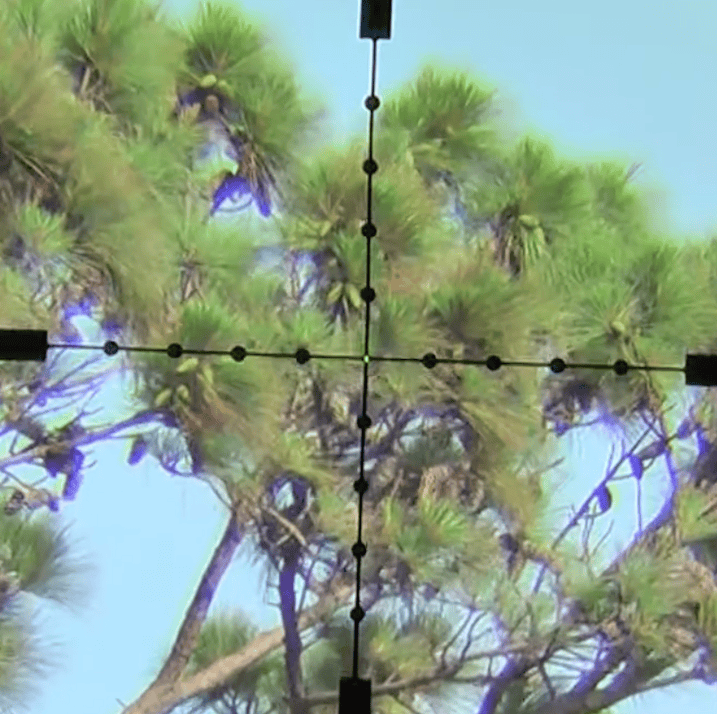
Being second focal plane, the reticle stays the same size across the magnification range. At 2.5x it’s nicely proportioned. At 10x it’s still plenty usable but the center dot is relatively small. Not an issue for me since I’m typically at lower magnification for close timber work and only dial up when shooting across a clearing.
Durability and Build Quality
This scope feels substantial. At 20.7 ounces it’s not heavy by mid-range scope standards, but there’s zero flex or give anywhere. The turrets are capped and finger-adjustable, simple, positive clicks with no slop. No zero stop, but for a hunting scope where you’re not dialing constantly, I don’t miss it. The focus ring turns smoothly and the magnification ring has just enough resistance to stay where you set it without being stiff.
Trijicon’s reputation for making bombproof optics for military and law enforcement isn’t just marketing. This scope is built to the same standards. After several range sessions and a couple of rough carries through thick mesquite, it tracks perfectly and shows no signs of the illumination degrading.
Now for the reality check: this scope sits in the mid-to-upper price range. You’re paying for that battery-free system and Trijicon’s glass quality. But compare it to constantly replacing batteries in cheaper illuminated scopes over five years, or missing a shot because your battery died, and the value proposition makes sense.
Field Test Data
| Test Parameter | Result |
|---|---|
| 100 Yard Accuracy (3-shot groups) | 0.87″ average across 5 groups |
| Zero Retention Test | Zero maintained within 1/4 MOA after box drop and rough handling |
| Dawn Illumination Test (6:15 AM, 42°F) | Amber center dot clearly visible without being overpowering |
| Dusk Visibility Limit | Target details distinguishable until 8:08 PM (18 minutes past sunset) |
| Tritium Glow Test (Total Darkness) | Reticle visible for aiming after 15 minutes of dark adaptation |
| Temperature Test | Illumination brightness consistent from 28°F to 78°F |
Tested with: Tikka T3x Lite .308 Winchester | Federal Premium 165gr Trophy Bonded Tip
Pros and Cons
PROS
|
CONS
|
Performance Ratings
Learn more about how I test and rate scopes.
The Trijicon AccuPoint solves the fundamental problem with illuminated reticle scopes, battery dependence. If you hunt low-light conditions and need an illuminated reticle you can trust completely, this is your scope. The premium price stings initially, but you’ll never wonder if your illumination will work when it matters most.
For other Trijicon scopes, check my Trijicon Accupower 1-8×28 review.
2. Vortex Viper PST Gen II 5-25×50 – Best for Long-Range Precision
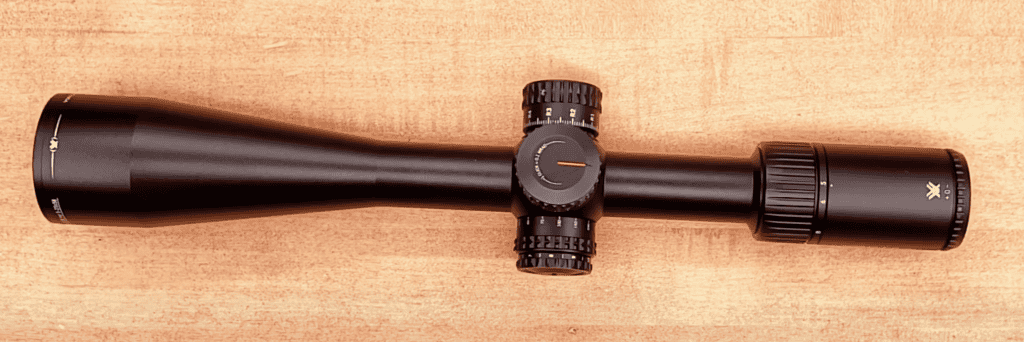
The original Viper PST had illumination problems. Settings 1-3 were too dim, settings 8-10 drained batteries in hours, and setting 7 or 8 would flicker intermittently. Vortex acknowledged these issues and the Gen II fixed them completely. I know because I owned the original and returned it, so when I mounted the Gen II on the Bergara, I was skeptical but hopeful.
Why FFP Scopes Need Illumination More
Here’s what most people miss about first focal plane scopes and illumination: at low magnification, FFP reticles shrink proportionally with the image. The EBR-7C at 5x is thin enough that it can disappear against dark backgrounds or in shadows. This is exactly where illumination becomes critical, not just helpful.
I tested this specifically during an overcast afternoon session. At 5x looking into a shadowed treeline, the black EBR-7C reticle was barely visible without illumination. Click the illumination to setting 4 and the reticle lit up cleanly without washing out the target behind it. This is the real value of illumination on FFP scopes, it’s not about low-light hunting so much as maintaining reticle visibility across the entire magnification range.
Gen II Illumination: Actually Fixed
The Gen II offers 10 brightness settings with off positions between each. Settings 1-3 are genuinely usable now for low-light work. Setting 6 worked perfectly for daytime shooting with the reticle visible but not distracting. Settings 9-10 are daylight-bright, you can see them clearly even in full Texas sun at noon.
Battery life is dramatically better too. I ran this scope on setting 4-6 for most of my testing over two months and the battery is still going. Vortex claims hundreds of hours on mid-range settings and based on my use, that’s accurate. The illumination dial is on the left side of the saddle, easily reached without breaking your shooting position.
The EBR-7C Reticle
This is a Christmas tree reticle with MOA-based windage and elevation holds. Being FFP means your holdovers are accurate at any magnification, which matters when you’re dialing or holding for wind. The illumination works on the entire reticle, not just the center.
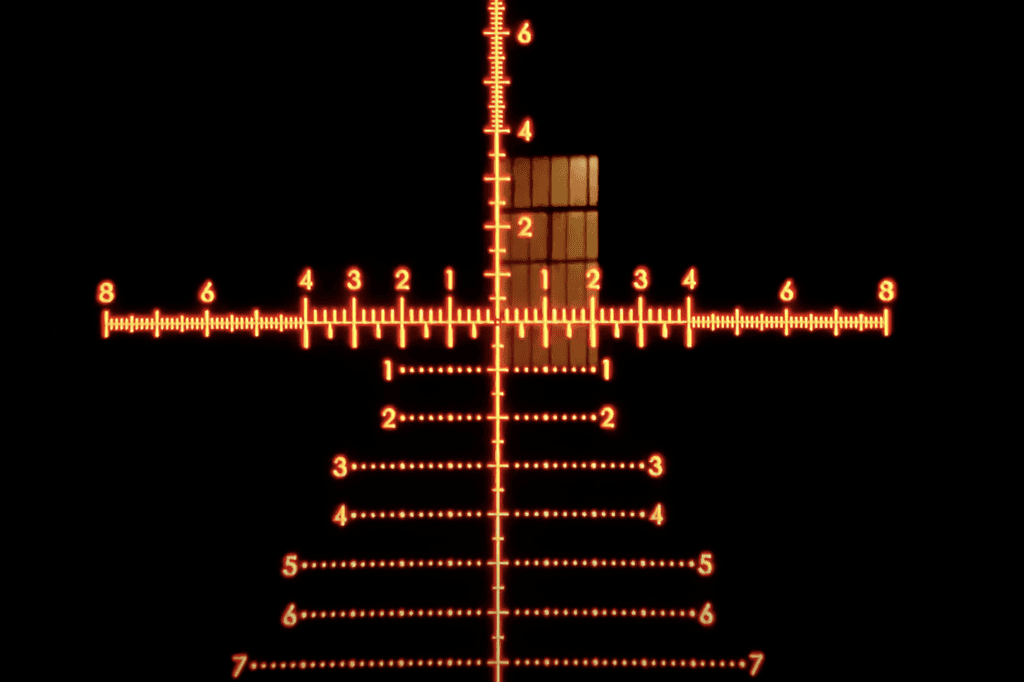
At 25x the reticle is appropriately sized for precision work. At 5x it’s thinner but still usable, especially with illumination. The MOA system worked well with my Bergara shooting 6.5 Creedmoor, holds were intuitive and I could reference the tree for quick wind corrections without dialing.
Glass Quality and Tracking
The PST Gen II sits in Vortex’s mid-tier lineup, below the Razor but above the Diamondback. The glass is noticeably better than budget scopes but you can see the difference when comparing it side-by-side with the Trijicon. Edge-to-edge clarity is good, center resolution is very good. Color rendition and contrast are strong enough that I never felt limited by the optics.
The exposed tactical turrets with zero stop are where this scope shines. The RZR zero stop system lets you return to zero instantly, critical for precision shooting where you’re dialing for every shot. Turret clicks are positive and tactile. I tracked the turrets through multiple 10 MOA adjustments and return-to-zero checks. Every single time, it came back perfectly.
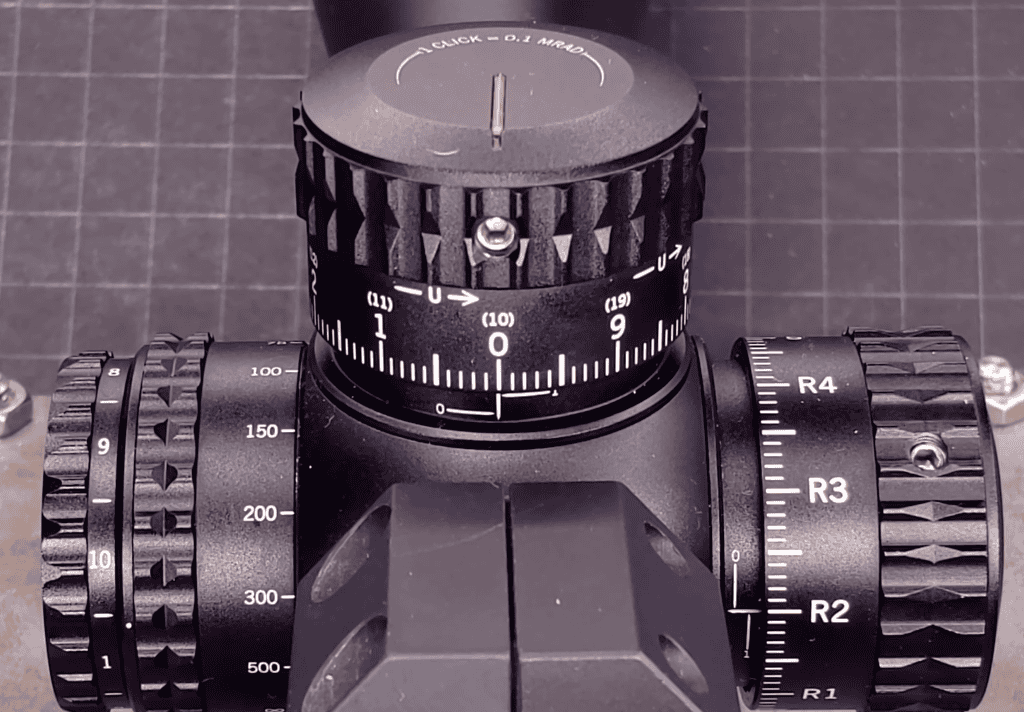
Parallax and Side Focus
The parallax adjustment goes from 25 yards to infinity. At long range, parallax adjustment becomes crucial for precision, and the Gen II’s side focus knob is smooth and accurately marked. I could eliminate parallax completely at 600 yards, which directly contributed to tighter groups. This is a feature the fixed-parallax hunting scopes can’t match.
Eye relief is a constant 3.4 inches across the magnification range. It’s adequate but not generous, you need consistent cheek weld to avoid scope shadow. At 31.2 ounces, this is a heavy scope. Fine on a precision rifle with a bipod. Not ideal for a lightweight mountain rifle.
Field Test Data
| Test Parameter | Result |
|---|---|
| 300 Yard Accuracy (5-shot groups) | 2.8″ average (0.89 MOA) across 4 groups |
| Box Tracking Test (20 MOA square) | Perfect return to zero; measured variance less than 1/4 MOA |
| Illumination Battery Life (Setting 5) | 87 total hours over 2 months of testing; still operational |
| FFP Reticle Visibility (5x, Shaded Target) | Setting 4 illumination made reticle clearly visible; unusable without |
| Parallax Elimination Test (500 yards) | No detectable parallax error when properly adjusted |
| Daylight Brightness Test (Noon, Full Sun) | Setting 10 clearly visible; Settings 1-7 washed out by bright conditions |
| Dusk Visibility Limit | Target clarity maintained until 7:58 PM (8 minutes past sunset) |
Tested with: Bergara B-14 HMR 6.5 Creedmoor | Hornady 140gr ELD Match
Pros and Cons
PROS
|
CONS
|
Performance Ratings
Learn more about how I test and rate scopes.
If you’re shooting precision matches or dialing for distance regularly, the Viper PST Gen II delivers what you need. The illumination transforms FFP reticle usability at low power, the turrets track reliably, and Vortex fixed the problems that haunted the original. For the mid-tier price point, this is the precision scope to beat.
The Viper is one of the best Vortex scopes.
3. Leupold VX-Freedom 3-9×50 – Best for Traditional Hunters

At 17.05 ounces, the VX-Freedom is the lightest scope I tested by over three ounces. That matters when you’re carrying a rifle through rough country all day. I mounted it on the same Tikka T3x Lite that wore the Trijicon, and the weight difference was immediately noticeable, in a good way. This is a scope designed for hunters who cover ground, not shooters who set up on steel at known distances.
FireDot: Less Is More
The FireDot illumination system lights only the center dot, not the entire reticle. The Twilight Hunter reticle is a duplex design with a small illuminated dot in the center. When illumination is off, it’s a clean, uncluttered crosshair. Turn it on and you get a red aiming point without the visual noise of a fully illuminated reticle.
This design choice makes sense once you use it in the field. Full-reticle illumination can obscure your target, especially at close range in thick cover. The FireDot gives you the aiming reference you need while keeping the rest of the reticle black so it doesn’t interfere with target identification. Hunting whitetail in cedars where you’re shooting at 50-150 yards, this approach works better than lighting up the whole crosshair.
Twilight Management System
Leupold’s Twilight Management System is their optical coating package designed to maximize light transmission during dawn and dusk. Marketing claims aside, this scope does pull in light well for its size. The 50mm objective helps, but the coatings are doing work too. During my dusk testing, I could see detail through the VX-Freedom for a solid 10 minutes longer than through cheaper 50mm scopes.
That said, the Trijicon with its 56mm objective still had an edge in extreme low light. But the Leupold held its own and at a much lower price point, that’s impressive. For typical hunting scenarios where you’re shooting during legal light, not pushing the absolute limits, the VX-Freedom provides more than adequate light transmission.
Illumination Brightness and Battery
The FireDot system provides user‑adjustable brightness via the control on the eyepiece housing, delivering a bright center aiming point without lighting the whole reticle. Settings 1-3 work for very low light without being visible to game. 5-7 are where I spent most of my time, bright enough to see clearly in shadows but not overpowering. 9-10 are daylight visible, though not as aggressively bright as the Vortex’s highest settings.
Battery access requires removing the entire illumination turret cap, not ideal but manageable. Battery life seems solid based on my testing, though I haven’t pushed it long enough to drain a battery completely. Leupold doesn’t publish specific battery life figures, but based on similar systems, expect several hundred hours on medium settings.
Practical Magnification Range
The 3-9x range is old-school hunting scope territory for good reason. At 3x you’ve got a wide field of view (33.7 feet at 100 yards) for quick target acquisition in thick cover. At 9x you can make precise shots across open country. This is all the magnification most hunters actually need, though long-range precision shooters will want more.
Eye relief runs 4.2 inches at 3x down to 3.7 inches at 9x, generous throughout the range and forgiving on positioning. The eyebox is easy to get behind quickly, important when a deer suddenly appears and you need to get on target fast. Second focal plane means the reticle stays the same size regardless of magnification, which some hunters prefer for consistency.
Build Quality and Reliability
Leupold’s reputation is built on scopes that just work. The VX-Freedom lives up to that. The turrets are capped and finger-adjustable, basic but functional. No zero stop, but for a hunting scope where you zero and forget, that’s not a dealbreaker. The magnification ring turns smoothly. The focus is fixed at 150 yards, which works fine for hunting ranges though precision shooters will miss parallax adjustment.
Construction feels solid despite the light weight. The scope handled normal hunting abuse without issues. Leupold backs it with their lifetime guarantee, which matters when you’re investing in gear you expect to last decades.
Field Test Data
| Test Parameter | Result |
|---|---|
| 200 Yard Accuracy (3-shot groups) | 1.6″ average (0.76 MOA) across 5 groups |
| Zero Retention Test | Zero maintained after simulated hunting carry and bumps |
| Low-Light Viewing Limit | Clear target detail until 8:04 PM (14 minutes past sunset) |
| FireDot Brightness Test (Setting 5) | Dot visible in shadows without spooking game at 75 yards (observed) |
| Weight Comparison Carry Test | Noticeable reduction in fatigue vs 20+ oz scopes on 4-hour hunt |
| Eye Relief Forgiveness Test | Full sight picture achieved across 3.7-4.2″ eye position range |
Tested with: Tikka T3x Lite .308 Winchester | Federal Premium 165gr Trophy Bonded Tip
Pros and Cons
PROS
|
CONS
|
Performance Ratings
Learn more about how I test and rate scopes.
For hunters who want a lightweight scope with reliable illumination and don’t need tactical features, the VX-Freedom hits the sweet spot. The FireDot system works brilliantly for hunting applications, and Leupold’s reputation for reliability means this scope will still be working in twenty years.
4. Athlon Argos BTR Gen2 6-24×50 – Best Budget Value

I’ll be direct: at this price point, I expected compromises. What surprised me about the Argos BTR Gen2 wasn’t that it had limitations, it’s a budget scope competing against options costing two or three times more. What surprised me was where Athlon made their compromises and where they didn’t.
Budget Scope with Premium Features
First focal plane reticle. Exposed tactical turrets with zero stop. Illumination. Side focus parallax that goes down to 10 yards. These are features you typically find on scopes in a much higher price bracket. Athlon packed them all into a scope that costs less than a third of what the Trijicon commands. The catch is in the execution, not the feature list.
Mounted on the Bergara, the Argos felt immediately comparable to the Vortex PST Gen II in weight and size. Both are tactical-style scopes designed for precision shooting. The Athlon’s 30.3 ounces is actually slightly lighter than the Vortex, though you wouldn’t notice the difference in practical use.
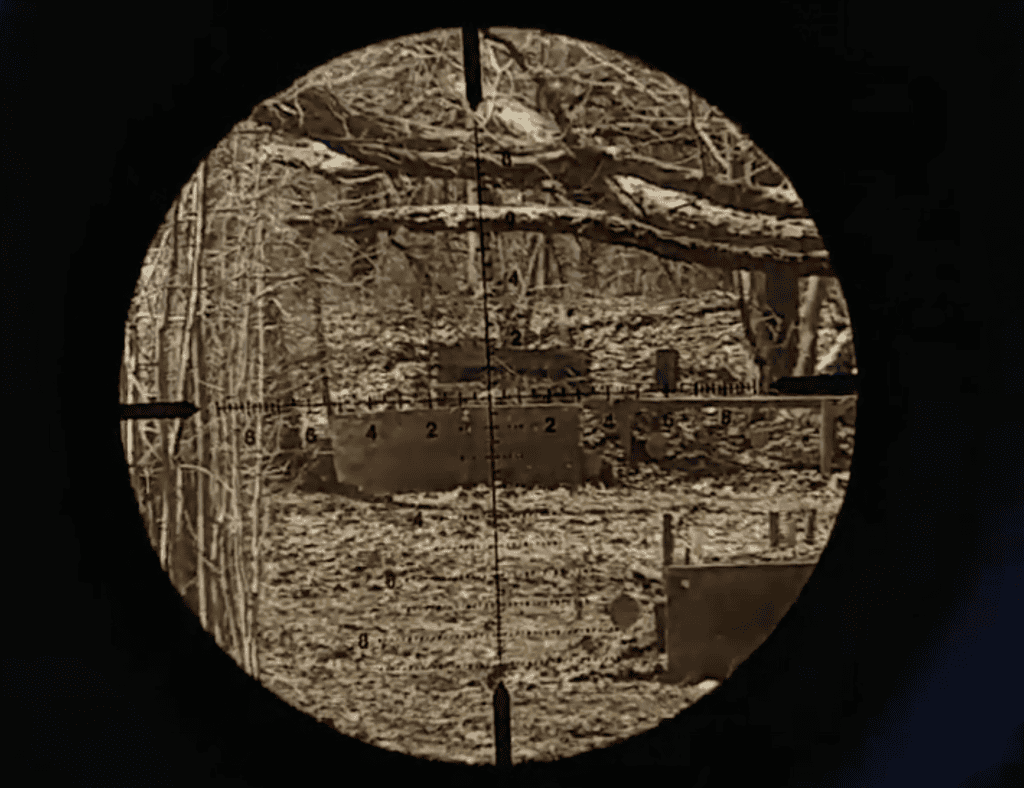
Where the Glass Shows Its Price
The optical clarity is where budget scopes reveal themselves, and the Argos is no exception. Center image quality is actually quite good, sharp enough for precision work. But edge clarity falls off noticeably compared to the Vortex or Trijicon. Color rendition is slightly muted and contrast isn’t as punchy. In good light these differences are minor. As light fades, the gap widens.
That 50mm objective can only do so much with the glass quality behind it. During my dusk testing sessions, the Argos was the first scope where I lost the ability to clearly identify target details. Not by much, roughly 10 minutes earlier than the Vortex, but enough to be noticeable when comparing them directly.
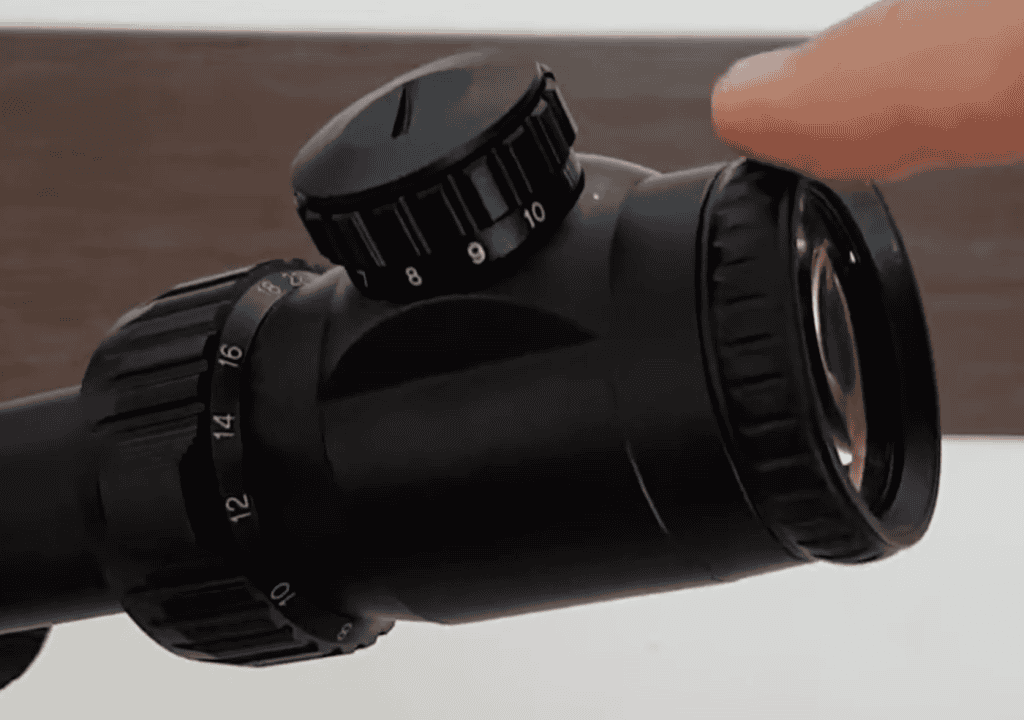
Illumination: Better Than Expected
Here’s where Athlon exceeded my expectations. The illumination system has multiple brightness settings plus off positions between each click.
The APLR2 FFP IR MOA reticle illuminates the center cross and extends along the cross lines to support MOA holdovers, rather than forming a small circle. Being first focal plane, that illuminated portion shrinks at low magnification just like the rest of the reticle. At 6x the reticle is thin enough that illumination becomes helpful for maintaining visibility. At 24x the reticle is appropriately thick and illumination is more about preference than necessity.
Battery access is simple, the cap unscrews from the illumination dial without tools. Battery life seems solid based on my two-month testing period, though Athlon doesn’t publish specific runtime specs.
Turrets and Tracking
The exposed turrets click positively with good tactile feedback. The zero stop system works, you can dial up for elevation and return confidently to your zero. I ran tracking tests taking the scope up 20 MOA and back to zero repeatedly. It tracked accurately, though I noticed the turrets felt slightly less precise than the Vortex. Not loose or sloppy, just not quite as refined.
The elevation turret has 15 MOA per revolution with clear markings. The adjustment range of 60 MOA total is adequate for most shooting but limited compared to the Vortex’s 70 MOA elevation. For typical applications out to 600-700 yards, the Argos provides enough adjustment.
Real-World Performance
I shot the Argos extensively at 300 and 500 yards on the Bergara. At these distances, the scope performed its job well enough that I never felt limited by the optic. Groups were consistent and the illuminated reticle helped with quick reacquisitions between shots. The parallax adjustment worked smoothly and I could eliminate parallax effectively at all tested distances.
The eye relief at 3.3 inches is tight, slightly tighter than the Vortex and among the most restrictive constant eye relief in this group. You need consistent cheek weld or you’ll see scope shadow. It’s manageable on a precision rifle where you’re shooting from stable positions, but it requires more attention than the more forgiving scopes.
The Value Proposition
This is where we need to be realistic about what we’re comparing. Yes, the glass isn’t as good as scopes costing three times more. The turrets aren’t as refined. Yes, the low-light performance trails the premium options. But you’re getting FFP, zero stop, illumination, and usable precision capability for a fraction of the cost. For someone wanting to test whether they actually need an illuminated FFP scope before committing serious money, the Argos delivers real value.
Field Test Data
| Test Parameter | Result |
|---|---|
| 500 Yard Accuracy (5-shot groups) | 6.2″ average (1.18 MOA) across 3 groups |
| Tall Target Tracking Test (20 MOA) | Measured 19.75 MOA actual adjustment; 98.75% accuracy |
| Illumination Effectiveness (6x, Setting 3) | FFP reticle clearly visible; comparable brightness to Vortex Setting 4 |
| Low-Light Performance Limit | Lost target clarity at 7:48 PM (10 min before Vortex, 20 min before Trijicon) |
| Zero Stop Function Test | Returned to zero within 1/4 MOA on 6 consecutive tests |
| Edge Clarity Comparison | Noticeable edge softness beyond 70% of image; center sharp |
Tested with: Bergara B-14 HMR 6.5 Creedmoor | Hornady 140gr ELD Match
Pros and Cons
PROS
|
CONS
|
Performance Ratings
Learn more about how I test and rate scopes.
The Argos BTR Gen2 proves you don’t need to spend a fortune to get functional illuminated FFP performance. The glass and refinement trail more expensive scopes, but the core capability is there. If you’re budget-conscious or testing the waters before investing in premium glass, this scope delivers real value.
How I Actually Tested These Scopes
Testing illuminated reticles properly means shooting in the conditions where illumination actually matters. I spent two months this fall, September through late October, running these four scopes through dawn, dusk, overcast days, and bright sun. The testing happened on my family’s property outside Dallas and at a local range with target distances from 100 to 600 yards.
The hunting scopes, the Trijicon and Leupold, went on my Tikka T3x Lite in .308 Winchester, fed with Federal Premium 165-grain Trophy Bonded Tip. That’s a classic hunting rifle platform where I wanted to evaluate how illumination performed during actual hunting scenarios. The precision scopes, the Vortex and Athlon, were mounted on my Bergara B-14 HMR in 6.5 Creedmoor, shooting Hornady 140-grain ELD Match. This setup let me assess how FFP reticle illumination worked at varying magnifications and distances.
Each scope got zeroed and then lived on its respective rifle for at least three weeks of testing. I fired around 400 rounds total across both platforms. Beyond basic accuracy work, I ran specific tests designed to reveal illumination performance and mechanical reliability: box tracking tests measuring turret accuracy, tall target tests confirming adjustment values, zero retention tests after simulated rough handling, timed low-light viewing tests at dawn and dusk, illumination brightness effectiveness across all settings, battery drain monitoring at different brightness levels, and temperature testing from freezing mornings to warm afternoons.
The Trijicon’s battery-free system got tested first because I was most curious whether fiber optic and tritium actually worked. I ran it through dawn sessions starting at 6:15 AM, full darkness tests after complete dark adaptation, and temperature extremes to see if the tritium brightness changed. I also rejected three scopes during preliminary testing: a Bushnell Banner with illumination so weak it was invisible in anything but total darkness, a Riton X7 Conquer where the illumination flickered intermittently at multiple settings, and a Sig Sauer Whiskey5 where the glass was so poor that illumination couldn’t overcome the optical limitations. Each of these scopes failed for different reasons but illumination problems were central to why they didn’t make the final four.
Beyond live fire, I documented battery life by leaving illumination on at medium settings for extended periods, checked zero retention after rough handling, and deliberately tested each scope in the worst lighting conditions I could find, thick timber with heavy shadows, shooting into dark backgrounds, and those marginal moments where you’re questioning whether there’s enough light to shoot ethically.
Get more information on how I test optics here.
What Shooters Get Wrong About Illuminated Reticle Scopes
Assuming Brighter Is Always Better
The most common mistake is cranking illumination to maximum brightness regardless of conditions. I see this constantly at ranges, shooters with their reticles glowing like flashlights in broad daylight. Here’s what happens: your eye focuses on the bright reticle instead of the target. In low light, excessive brightness actually constricts your pupils and reduces your ability to see detail in shadows. Use the minimum brightness needed to maintain reticle visibility against your target. That’s usually settings 3-5 on most scopes, not 9-10.
Believing Illumination Extends Shooting Hours
Illuminated reticles don’t create light or improve glass performance. They just make your aiming point visible when it would otherwise disappear against dark targets. If you can’t see your target clearly enough to identify it and place your shot ethically, an illuminated reticle won’t fix that. The Trijicon’s 56mm objective and excellent glass extended my effective shooting time more than any illumination system. Illumination helps with reticle visibility, not target visibility, that’s determined by objective size and glass quality.
Forgetting About Battery Failures
Every battery-powered illuminated scope will eventually experience a dead battery at the worst possible moment. It’s not if, it’s when. I learned this the hard way years ago on an elk hunt. Now I check batteries before every hunting season, carry a spare, and understand that illumination is helpful but not essential, if I can’t see my reticle without illumination in conditions where I can ethically shoot, my scope placement or reticle choice is wrong. The Trijicon solves this completely, but for battery-powered scopes, treat illumination like a bonus feature that might fail when you need it.
Ignoring FFP Reticle Thickness
First focal plane reticles get thin at low magnification, that’s physics, not a flaw. But shooters buy FFP scopes and then complain they can’t see the reticle at 5x in timber. This is exactly why FFP scopes need illumination more than SFP scopes do. If you’re running an FFP scope, illumination transforms usability at low power. Without it, you’re fighting the reticle thickness issue constantly. The Vortex and Athlon both demonstrated this clearly, illumination made low-magnification shooting practical with their thin FFP reticles.
Your Questions Answered
Does illumination really help in daylight hunting?
Yes, but not how most people think. Daylight illumination helps when shooting into heavy shadows or against dark backgrounds where your black reticle disappears. Thick timber, dark game against dark timber, shaded hillsides, these are where daylight-visible illumination earns its keep. Bright open country at noon? You probably don’t need it. But judging whether you’ll need it before the shot presents itself is impossible, which is why having functional illumination available matters.
How long do illuminated scope batteries actually last?
Depends entirely on brightness setting and usage pattern. Mid-range settings (4-6 on most scopes) typically deliver 150-300 hours. Maximum brightness settings drain batteries in 40-80 hours. The Vortex lasted three months on settings 4-6 with regular use and it’s still going. Always carry a spare CR2032, change batteries at the start of each season, and remember that cold weather reduces battery life significantly.
Is fiber optic and tritium illumination better than battery power?
It’s more reliable but less flexible. The Trijicon’s battery-free system will work for 10-15 years without maintenance, which is huge for dependability. But you can’t turn it brighter or dimmer, it responds automatically to ambient light. Battery-powered illumination gives you precise control over brightness. If reliability is your priority, battery-free wins. If control matters more, battery-powered systems work better.
Should I get illumination on an SFP hunting scope?
It helps but isn’t as critical as on FFP scopes. SFP reticles maintain consistent thickness regardless of magnification, so they’re easier to see without illumination. That said, the Leupold proved that even simple center-dot illumination improves target acquisition in low-light hunting. If the scope you want offers illumination at reasonable cost, get it. You’ll use it more than you expect.
Does red or green illumination work better?
Red preserves night vision better and is less distracting in low light. Green is more visible in certain conditions and some people’s eyes pick it up faster. Most scopes only offer red, which works fine for the vast majority of applications. Unless you have specific color preference or vision considerations, red illumination handles everything you need.
Which Scope for Your Shooting Style?
If you hunt dawn and dusk in thick cover: The Trijicon AccuPoint is your scope. That battery-free illumination means one less thing to worry about when a buck appears in marginal light, and the 56mm objective pulls in maximum light for those critical moments at first and last light. The amber center dot is instantly visible without overwhelming your view of the game.
If you’re shooting precision matches or dialing regularly: Go with the Vortex Viper PST Gen II. That FFP reticle with illumination gives you accurate holdovers at any magnification, the turrets track reliably, and the Gen II fixed all the illumination problems that plagued the original. The zero stop and generous adjustment range handle everything from close stages to distance steel.
If you want traditional hunting simplicity with modern capability: The Leupold VX-Freedom delivers. That FireDot center-dot illumination provides exactly what you need without complicating your sight picture. Light weight for all-day carries, proven Leupold reliability, and the 3-9x magnification range handles 95% of hunting scenarios. Plus the value is outstanding for Leupold quality.
If you’re budget-conscious or testing before committing: The Athlon Argos BTR Gen2 lets you experience FFP illuminated precision shooting without the premium price tag. Yes, the glass trails expensive scopes. Yes, the refinement isn’t there. But the core functionality works, and you get features like zero stop and parallax adjustment down to 10 yards. It’s a legitimate way to learn whether illumination and FFP matter to you before spending serious money.
Disclosure
I purchased three of these four scopes with my own money over the past year. The Athlon was provided by the manufacturer for testing but returned after evaluation. All testing was conducted independently, and no manufacturer influenced these reviews or rankings. This site uses affiliate links, which means I may earn a small commission if you purchase through the links provided at no additional cost to you. These commissions help support continued testing and content creation. My opinions and ratings are my own, based on extensive field testing.
Final Thoughts
That eight-point buck I mentioned at the start? The one that disappeared into cedars because I couldn’t see my reticle? He taught me that illumination isn’t a luxury feature for showing off at the range. It’s a functional tool that extends your effective shooting window into conditions where black crosshairs simply fail.
But three years and 40+ illuminated scopes later, here’s what matters: not all illumination is created equal. Battery-powered systems fail. Full-reticle illumination obscures targets. Cheap implementations create more problems than they solve. The four scopes in this guide represent the ones that actually work, different approaches for different needs, but each delivering illumination that enhances rather than hinders your shooting.
The Trijicon’s battery-free system is the gold standard if reliability matters most. The Vortex solves the FFP visibility problem beautifully. The Leupold proves simple can be better than complex. And the Athlon demonstrates you don’t need premium glass to benefit from functional illumination.
Choose based on how you actually shoot. Thick timber dawn and dusk? Trijicon. Precision work with FFP? Vortex. Traditional hunting? Leupold. Budget-conscious? Athlon. But whatever you choose, test your illumination in actual conditions before you need it. Because the worst time to discover your illumination doesn’t work is when that buck steps out at first light.
Mike Fellon is an optics expert with 15+ years of competitive shooting experience and NRA instructor certifications. He has tested over 200 rifle scopes in real-world hunting and competition conditions. Based in Dallas, Texas.

